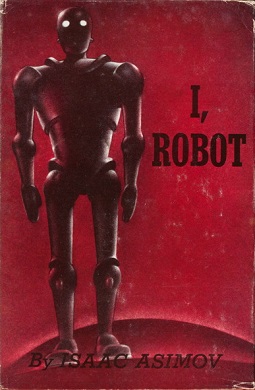
I, Robot is a fixup collection made up of science fiction short stories by American writer Isaac Asimov. The stories originally appeared in the American magazines Super Science Stories and Astounding Science Fiction between 1940 and 1950 and were then compiled into a single publication by Gnome Press in 1950, in an initial edition of 5,000 copies.

Isaac Asimov was an American writer and professor of biochemistry at Boston University. During his lifetime, Asimov was considered one of the "Big Three" science fiction writers, along with Robert A. Heinlein and Arthur C. Clarke. A prolific writer, he wrote or edited more than 500 books. He also wrote an estimated 90,000 letters and postcards. Best known for his hard science fiction, Asimov also wrote mysteries and fantasy, as well as popular science and other non-fiction.

The Caves of Steel is a science fiction novel by American writer Isaac Asimov. It is a detective story and illustrates an idea Asimov advocated, that science fiction can be applied to any literary genre, rather than just being a limited genre in itself.
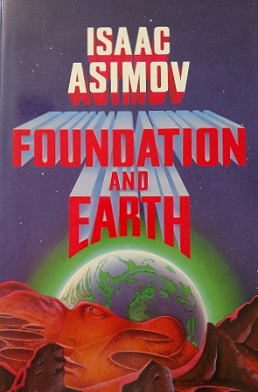
Foundation and Earth is a science fiction novel by American writer Isaac Asimov, the fifth novel of the Foundation series and chronologically the last in the series. It was published in 1986, four years after the first sequel to the Foundation trilogy, which is titled Foundation's Edge.
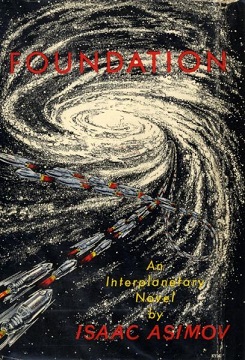
The Foundation series is a science fiction book series written by American author Isaac Asimov. First published as a series of short stories and novellas in 1942–50, and subsequently in three books in 1951–53, for nearly thirty years the series was widely known as The Foundation Trilogy: Foundation (1951), Foundation and Empire (1952), and Second Foundation (1953). It won the one-time Hugo Award for "Best All-Time Series" in 1966. Asimov later added new volumes, with two sequels, Foundation's Edge (1982) and Foundation and Earth (1986), and two prequels, Prelude to Foundation (1988) and Forward the Foundation (1993).
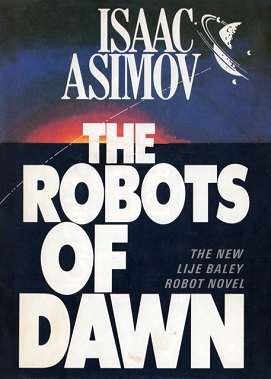
The Robot Series is a series of thirty-seven science fiction short stories and six novels created by American writer Isaac Asimov, from 1940 to 1995. The series is set in a world where sentient positronic robots serve a number of purposes in society. To ensure their loyalty, the Three Laws of Robotics are programmed into these robots, with the intent of preventing them from ever becoming a danger to humanity. Later, Asimov would merge the Robot series with his Foundation series.

The Three Laws of Robotics are a set of rules devised by science fiction author Isaac Asimov, which were to be followed by robots in several of his stories. The rules were introduced in his 1942 short story "Runaround", although similar restrictions had been implied in earlier stories.

Nemesis is a science fiction novel by American writer Isaac Asimov. One of his later science fiction novels, it was published in 1989, three years before his death. This novel is connected to Asimov's other works by several ideas from earlier and later novels, including non-human intelligence, sentient astronomical bodies ("Hallucination"), and rotor engines.

Janet Opal Asimov, usually writing as J. O. Jeppson, was an American science fiction writer, psychiatrist, and psychoanalyst.
"Blind Alley" is a science fiction short story by American writer Isaac Asimov. It was first published in the March 1945 issue of Astounding Science Fiction, and later included in the collection The Early Asimov (1972).

"The Last Question" is a science fiction short story by American writer Isaac Asimov. It first appeared in the November 1956 issue of Science Fiction Quarterly and in the anthologies in the collections Nine Tomorrows (1959), The Best of Isaac Asimov (1973), Robot Dreams (1986), The Best Science Fiction of Isaac Asimov (1986), the retrospective Opus 100 (1969), and in Isaac Asimov: The Complete Stories, Vol. 1 (1990). While he also considered it one of his best works, "The Last Question" was Asimov's favorite short story of his own authorship, and is one of a loosely connected series of stories concerning a fictional computer called Multivac. Through successive generations, humanity questions Multivac on the subject of entropy.

Norby, the Mixed-Up Robot is the first book in the Norby series by American authors Janet Asimov and Isaac Asimov. In it, Jefferson Wells and Norby stop Ing from taking over the Solar System with the help of Jeff's brother Fargo Wells, police officer Albany Jones, and Admiral Boris Yobo. According to Isaac Asimov, although Janet Asimov did 90% of the work, his "name was wanted on the book for the betterment of sales [and he] went over the manuscript and polished it a bit." It, along with its sequel, was illustrated for Boys' Life.

Norby is a fictional robot created by Janet Asimov and Isaac Asimov who stars in his own series of children's science fiction books, The Norby Chronicles. His first appearance was in the 1983 book Norby, the Mixed-Up Robot, in total he appeared in 11 novels in the 'Norby' series. According to Isaac Asimov, although Janet Asimov did 90% of the work, his "name was wanted on the book for the betterment of sales [and he] went over the manuscript and polished it a bit."
"Farewell to the Master" is a science fiction short story by American writer Harry Bates. It was first published in the October 1940 issue of Astounding Science Fiction on page 58. It provided the basis of the 1951 film The Day the Earth Stood Still and its 2008 remake. In 1973, the story was adapted by Marvel Comics for its Worlds Unknown series. According to Gizmodo, the 1973 adaptation was more faithful to the original story than was the 1951 film.
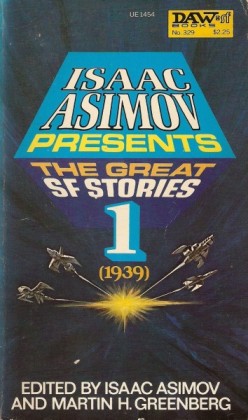
Isaac Asimov Presents The Great SF Stories 1 (1939) is an American collection of short stories, edited by Isaac Asimov and Martin H. Greenberg, originally published by DAW books in March 1979. It contains science fiction stories selected by the editors that were published in the year 1939. The book is part of a 25 volume series. Each successive volume in the series contains stories from the next year, continuing through 1963. The series starts with 1939 because Asimov had previously published a three volume anthology series titled, "Before the Golden Age", covering years 1931 - 1938, which he considered to be definitive for those years. According to DAW, The Great SF Stories 1 (1939) "is the first in what Isaac Asimov plans to be a definitive series of sf anthologies, covering year by year the truly memorable stories that have progressively brought science fiction to its present prominence". The second volume of the series is Isaac Asimov Presents The Great SF Stories 2 (1940).
The Foundation universe is the future history of humanity's colonization of the galaxy, spanning nearly 25,000 years, created through the gradual fusion of the Robot, Galactic Empire, and Foundation book series written by American author Isaac Asimov.

Opus 200 is Isaac Asimov's joint two-hundredth book, along with his autobiography In Memory Yet Green. It was published by Houghton Mifflin in March 1979. Asimov chose to celebrate the publication of his two hundredth book by writing about his previous 198 books, including excerpts from short stories and novels, as well as nonfiction articles and books. Opus 200 also includes three complete science fiction stories, two complete mystery stories and two complete essays.
In a writing career spanning 53 years (1939–1992), science fiction and popular science author Isaac Asimov (1920–1992) wrote and published 40 novels, 383 short stories, over 280 non-fiction books, and edited about 147 others.
Depending on the counting convention used, and including all titles, charts, and edited collections, there may be currently over 500 books in Isaac Asimov's bibliography—as well as his individual short stories, individual essays, and criticism. For his 100th, 200th, and 300th books, Asimov published Opus 100 (1969), Opus 200 (1979), and Opus 300 (1984), celebrating his writing.
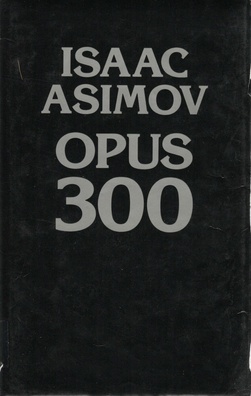
Opus 300 is a collection by American writer and scientist Isaac Asimov. It was published by Houghton Mifflin in the United States in 1984, and by Robert Hale Ltd in the United Kingdom in 1985. Asimov chose to celebrate the publication of his three hundredth book by writing about his previous 99 books, including excerpts from short stories and novels, as well as nonfiction articles and books. Opus 300 also includes nine complete stories, several complete science essays, and one complete essay never before published, "The Forever Generation," which is not available anywhere else.














